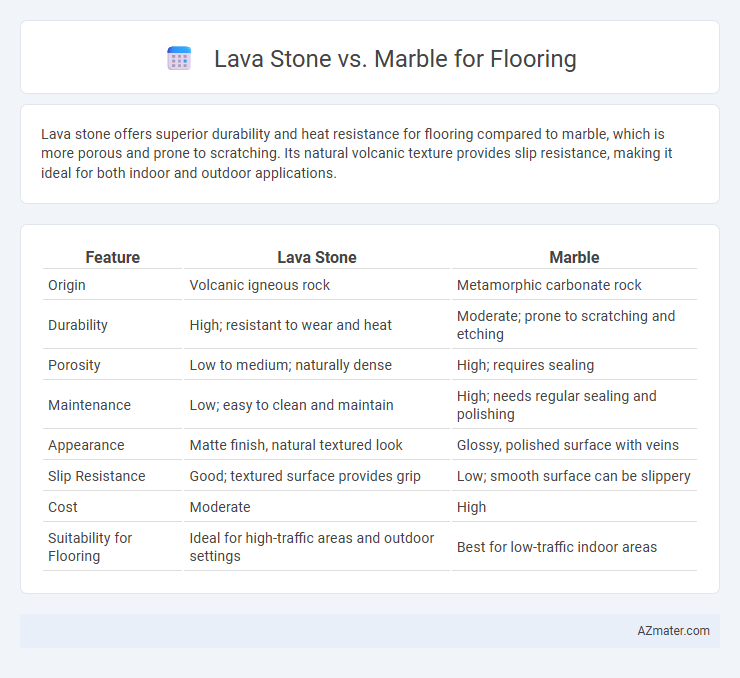Lava stone offers superior durability and heat resistance for flooring compared to marble, which is more porous and prone to scratching. Its natural volcanic texture provides slip resistance, making it ideal for both indoor and outdoor applications.
Table of Comparison
| Feature | Lava Stone | Marble |
|---|---|---|
| Origin | Volcanic igneous rock | Metamorphic carbonate rock |
| Durability | High; resistant to wear and heat | Moderate; prone to scratching and etching |
| Porosity | Low to medium; naturally dense | High; requires sealing |
| Maintenance | Low; easy to clean and maintain | High; needs regular sealing and polishing |
| Appearance | Matte finish, natural textured look | Glossy, polished surface with veins |
| Slip Resistance | Good; textured surface provides grip | Low; smooth surface can be slippery |
| Cost | Moderate | High |
| Suitability for Flooring | Ideal for high-traffic areas and outdoor settings | Best for low-traffic indoor areas |
Introduction: Lava Stone vs Marble Flooring
Lava stone flooring offers unmatched durability and natural heat resistance, making it ideal for high-traffic areas and warm climates. Marble flooring is prized for its elegant veining and polished finish, often enhancing luxury interiors with a timeless aesthetic. Both materials provide distinct textures and maintenance needs, impacting long-term flooring performance and cost-effectiveness.
Material Composition and Origin
Lava stone, formed from cooled volcanic lava, is an igneous rock known for its porous texture and natural durability, originating primarily from volcanic regions such as Italy and Indonesia. Marble, a metamorphic rock composed mainly of recrystallized carbonate minerals like calcite or dolomite, is sourced from regions including Italy's Carrara quarries and Greece, valued for its smooth surface and distinctive veining. The mineral composition of lava stone offers high resistance to heat and wear, while marble's crystalline structure provides elegance but requires careful maintenance to prevent acid etching.
Aesthetic Appeal and Design Versatility
Lava stone offers a unique, volcanic texture with deep, earthy tones that create a bold and natural aesthetic for flooring, contrasting with marble's classic, elegant veining and polished finish that exudes luxury. The design versatility of lava stone is ideal for rustic, modern, and industrial interiors, while marble complements traditional, contemporary, and minimalist styles with its wide range of colors and intricate patterns. Both materials enhance visual appeal but cater to distinct design themes, making the choice dependent on the desired ambiance and architectural context.
Durability and Hardness Comparison
Lava stone offers exceptional durability due to its volcanic origin, typically rating between 6 and 7 on the Mohs hardness scale, making it highly resistant to scratches and wear. Marble, while elegant and widely used, has a lower hardness rating of around 3 to 5, making it more susceptible to scratching, etching, and staining from acidic substances. For high-traffic areas requiring robust flooring, lava stone provides superior long-term resilience compared to marble.
Maintenance and Cleaning Requirements
Lava stone flooring requires minimal maintenance with periodic sealing to preserve its natural porous surface and prevent staining, making it highly durable and resistant to wear. Marble floors demand regular cleaning with pH-neutral cleaners and frequent resealing to protect against scratches, etching, and staining due to its softer, more porous nature. Both materials benefit from prompt spill cleanup, but lava stone's robust texture offers easier upkeep in high-traffic areas compared to the delicate care marble flooring necessitates.
Cost Analysis: Lava Stone vs Marble
Lava stone flooring typically costs between $5 to $12 per square foot, offering a more budget-friendly option compared to marble, which ranges from $10 to $30 per square foot depending on quality and origin. Installation costs for lava stone are generally lower due to its durability and ease of maintenance, whereas marble requires skilled labor to handle its fragility and polishing needs. Long-term expenses also favor lava stone as it resists staining and scratching better, reducing maintenance and replacement costs compared to the higher upkeep demands of marble flooring.
Slip Resistance and Safety Considerations
Lava stone offers superior slip resistance compared to marble due to its naturally rough and porous surface, making it a safer choice for flooring in wet or high-traffic areas. Marble, while elegant and durable, tends to become slippery when polished or wet, increasing the risk of slips and falls without proper treatment or anti-slip finishes. Prioritizing slip resistance, especially in environments prone to moisture, lava stone provides enhanced safety and reduces accident potential.
Environmental Impact and Sustainability
Lava stone flooring offers superior environmental benefits over marble, as it is formed from volcanic rock, making it abundant and renewable with minimal extraction impact. Marble quarrying involves significant landscape disruption, high water consumption, and carbon emissions from heavy machinery. The durability and low maintenance of lava stone reduce the need for frequent replacements, enhancing its sustainability profile compared to marble.
Installation Process and Challenges
Lava stone flooring requires specialized installation techniques due to its porous nature, demanding thorough sealing and precise cutting to prevent cracking and moisture absorption. Marble, while easier to cut and shape, involves careful handling to avoid surface etching and requires a flat subfloor to prevent cracking and uneven wear. Both materials necessitate skilled labor, but lava stone's weight and texture pose more significant challenges during transportation and fitting compared to marble's relatively smoother finish.
Best Use Cases and Suitability
Lava stone flooring excels in outdoor and high-traffic areas due to its durability, heat resistance, and slip-resistant properties, making it ideal for patios, walkways, and pool surrounds. Marble flooring suits elegant indoor spaces such as living rooms, foyers, and bathrooms where its luxurious appearance and smooth finish enhance aesthetics, but it requires careful maintenance to avoid staining and scratching. Choosing between lava stone and marble depends on environmental exposure and desired aesthetic, with lava stone favored for rugged, practical applications and marble preferred for refined, decorative interiors.

Infographic: Lava stone vs Marble for Flooring
 azmater.com
azmater.com